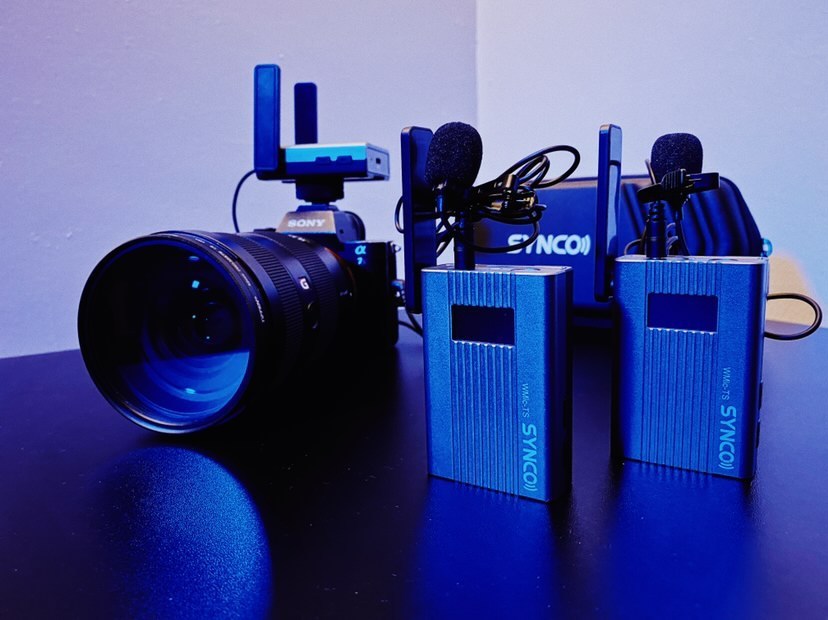The technology for wireless microphone system is growing mature and this type of sound recording is becoming popular. In this article, we would like to talk about 2 main types of this kind of microphone.

How to setup a wireless microphone system?
A professional wireless microphone system like SYNCO G2(A2) has essentially the same basic components. They would be a microphone, transmitter/transmitters that is/are built into a handheld mic or a separate bodypack unit, and a receiver with one or more antennas. The receiver’s output is always connected to the mixer.
Generally speaking, the sound is captured by the microphone that is built in or plugged into the transmitter, and then it is delivered to the receiver. It is the microphone receiver that processes the sound into standard sound signal and sends it to the speaker.
UHF, which is fully known as ultra-high frequency running at 470-698 MHz TV-band, and new-generation digital 2.4GHz are two typical types of wireless signal transmission that are applied by many microphone manufacturers to the microphone manufacturing.
Go and buy SYNCO wireless microphone at Moman PhotoGears Store
Which is better: UHF or 2.4 GHz?
The brandnew wireless mic system at 2.4GHz is supposed to challenge the UHF one. In fact, they are totally different and play their roles in different applications.
Definition
The 2.4GHz system operates in 83 MHz of spectrum between 2.400GHz and 2.483GHz and is always called wireless digital microphone system, while most of the traditional UHF kind in use today operate at lower UHF frequencies between 470MHz and 698MHz.
Check the video to see the new launch 2.4G wireless microphone at SYNCO.
Pros & cons in use
The 2.4 GHz wireless microphone system is highlighted because of its commonly used 2.4G type signal transmission which is not restricted by frequency band. It can be used in the same frequency range in nearly every country in the world, though the rules for wireless mics vary from country to country. Mostly, the digital wireless microphone system gives users a free pass.
However, its downsides are obvious. That is the channel limitation. Such mics are not able to offer as many channels as expected because 2.4 GHz chips operate on less spectrum, and because 2.4 GHz is so crowded with Bluetooth and Wi-Fi devices. Hence, there would be dropouts or noises when 2.4 gigahertz wireless mic is used in the recording.
By contrast, the UHF wireless microphone system designed for broadcast-quality recording is somehow professional. It is recommended for longer wavelength, a farther distance of signal transmission, fewer devices within the same frequency, and less interference.
Of course, it also has disadvantages. It consumes much more energy because it needs greater power.
Differences in application
For users seeking a wireless podcast microphone and suchlike, the general rule is to choose a 2.4 one if you only need a few channels, work relatively short distances, want operational simplicity, and make sure that your device will not be phased out depending on the future FCC changes. Mostly it is common in microphone for vlogging and other personal entertainment.
For users needing lots of channels, ultra-low latency, and are capturing critical sound at a large stage, sports, or podcasting events, premium-marketed UHF systems remain the best choice for ultimate audio quality.
SYNCO has multiple wireless microphone systems
SYNCO provides the aforementioned 2 types of wireless microphone system, namely G Series for systems at 2.4 GHz and T Series for those at UHF band. Here are introductions about 2 typical products.

Key features of SYNCO digital microphone wireless at 2.4GHz:
- Ultra-compact: each transmitter and receiver weigh less than 40g
- High-quality inbuilt microphone or external omnidirectional microphone included for truly wireless audio
- SYNCO SyncoderTM Encrypted Transmission Algorithm to achieve accurate audio signal pickup and DSP technology to make real-time audio optimization - studio-quality audio performance is ensured!
- 150m range of transmission (line of sight) at maximum
- One and dual wireless microphone system: 1-trigger-1 and 1-trigger-2 setup
- Wireless microphone for phone only or for DSLR camera mainly

Key features of SYNCO WMic-TS, the only wireless microphone system at UHF band:
- Unique SYNCO Noise Blocker to lock out every possible interference
- Smooth recording at a distance of 150m (line-of-sight) with 60 selectable channels
- Foldable antennas to maintain stable transmission and offer convenience to carry around
- Selectable high/low signal strengths for different recording conditions
- Rechargeable Li-ion battery to support 8.5-hour recording after each full charging
- 1-connect-1 UHF wireless microphone setup is also available with similar features
For more mics, see Guide to best budget wireless microphone system.
Go and buy SYNCO wireless microphone at Moman PhotoGears Store
National policies about UHF and 2.4 GHz band
Here are some national policies we need to know against 2.4G and UHF bands.
- National restriction on power: the digital wireless microphone is always restricted to use power within 10mW, while UHF wireless mic within 50mW. The transmission power has an impact on the range of sound pickup. Therefore, the 2.4G band has a shorter sound pickup distance than the UHF band.
- National protection of the UHF frequency band: Some countries charge UHF bands. It’s suggested that it should first use the UHF wireless microphone receiver to scan frequencies and find a frequency of stability once started. This would take about 1-2 minutes. A signal detector can be adopted to make sure that the signal is stable.

